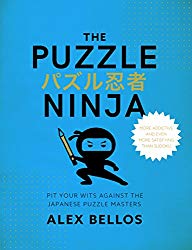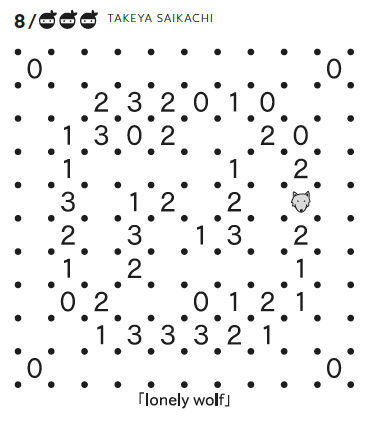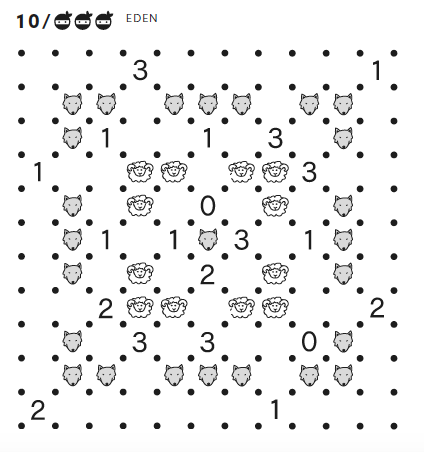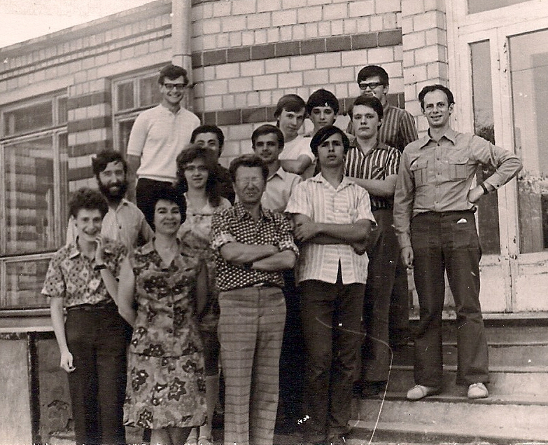14th December 2018, 12:19 pm
Alex Bellos sent me his new book Puzzle Ninja: Pit Your Wits Against The Japanese Puzzle Masters. What has he done to me? I opened the book and couldn’t close it until I solved all the puzzles.
This is a fantastic book. There are many varieties of puzzles, including
some types that I’ve never seen before. Also, the beautifully designed
puzzles are great. Often puzzles of the same type target different
solving ideas or have varied cool themes.
This book is more than a bunch of puzzles; it also contains poetic
stories about puzzle histories and Japanese puzzle designers. Fantastic
puzzles together with a human touch: this might be my favorite puzzle
book.
I present two puzzles from the book. The puzzle type is called Wolf and Sheep Slitherlink.
The Slitherlink is a famous puzzle type with the goal of connecting
some of the neighboring dots into a single non-self-intersecting loop. A
number inside a small square cell indicates how many sides of the
square are part of the loop. Wolf and Sheep Slitherlink is a variation of Slitherlink in which all sheep should be kept inside the fence (loop) and all the wolves outside.
Ignore the numbers in the title as they just indicate the order number
of Wolf and Sheep Slitherlink puzzles in the book. The number of ninja
heads shows the level of difficulty. (The hardest puzzles in the book
have four heads.) The difficulty is followed by the name of the puzzle
master who designed the puzzle.
The first puzzle above is slightly easier than the second. I like the
themes of these two puzzles. In the first one, only one cell—lonely
wolf—marks the relationship to the fence. In the second one, the wolf in
the center—who needs to be outside the fence—is surrounded by a circle
of sheep who are in turn surrounded by a circle of wolves.
Share:





13th December 2018, 01:48 pm
My friend Alex Ryba uses interesting math questions in the CUNY Math
Challenge. For the 2016 challenge they had the following problem.
Problem. Eve owns two six-sided dice. They are not necessarily fair dice and not necessarily weighted in the same
manner. Eve promises to give Alice and Bob each a fabulous prize if they each roll the same sum with her
dice. Eve wishes to design her two dice to minimize the likelihood that she has to buy two fabulous prizes.
Can she weight them so that the probability for Alice and Bob to get prizes is less than 1/10?
The best outcome for Eve would be if she can weight the dice so that the
sum is uniform. In this case the probability that Alice and Bob get the
prizes is 1/11. Unfortunately for Eve, such a distribution of weight
for the dice is impossible. There are many ways to prove it.
I found a beautiful argument by Hagen von Eitzen on the stack exchange: Let ai (correspondingly bi) be the probabilities that die A (correspondingly B) shows i + 1. It would be very useful later that that i ranges over {0,1,2,3,4,5} for both dice. Let f(z) = ∑ aizi and g(z) = ∑ bizi. Then the desired result is that f(z)g(z) = ∑j=010 zj/11.
The roots of the right side are the non-real roots of unity. Therefore
both f and g have no real roots. So, they must both have even degree.
This implies a5=b5=0 and the coefficient of z10 in their product is also 0, contradiction.
Alex himself has a straightforward argument. The probabilities of 2 and 12 have to be equal to 1/11, therefore, a0b0 = a5b5 = 1/11. Then the probability of a total 7 is at least a0b5 + a0b5. The geometric mean of a0b5 and a0b5
is 1/11 (from above), so their arithmetic mean is at least 1/11 and
their sum is at least 2/11. Therefore, the uniform distribution for sums
is impossible.
So 1/11 is impossible, but how close to it can you get?
Share:





11th December 2018, 03:39 pm
I just got this picture from my friend Victor Gutenmacher, which I never
saw before. My 1975 IMO team is posing at our training grounds before
the Olympiad trip to Bulgaria.
Left to right: Boris Yusin, Yuri Ionin, Zoya Moiseyeva (front), Gregory
Galperin (back), me, Ilya Yunus, Valentin Skvortsov, Aleksandr
Kornyushkin, Sergei Finashin, Sergei Fomin (front), Alexander Reznikov
(back), Yuri Shmelev (front), Yuri Neretin (back), Victor Gutenmacher.
Our coaches are in the shot as well. Surprisingly, or not surprisingly,
all of them moved to the USA. Yuri Ionin, now retired, was a professor
at Central Michigan University. Gregory Galperin is a professor at
Eastern Illinois University. Sergei Fomin is a professor at the
University of Michigan. Victor Gutenmacher worked for BBN Technologies
and Siemens PLM Software, and is now retired.
There are two more adults in the picture: Valentin Anatolievich
Skvortsov, our leader and Zoya Ivanovna Moiseyeva, our deputy leader.
Skvortsov was working at the math department of Moscow State University
at that time. The University was angry that he didn’t block some
students with Jewish heritage from the team thus allowing them to be
accepted to Moscow State University without exams. I wrote a story of how Zoya persuaded Alexander Reznikov not to go to Moscow University to help Valentin. It ruined Alexander’s live, and didn’t even help Valentin. 1975 was Valentin’s last trip as the leader.
Share:





5th December 2018, 12:50 pm



